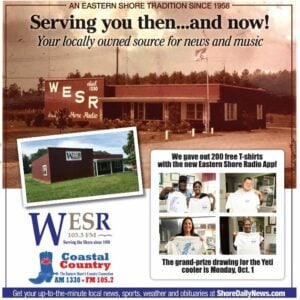
Three Eastern Shore Bayside locations have been listed by the World Atlas website as among the “Most Underated Coastal Hamlets in Virginia.”
Cape Charles leads the list.
According to the web article, “This historic coastal hamlet is known for a big, beautiful public beach with a LOVE sign. Secluded at the south tip of the Eastern Shore, Cape Charles delivers a reinvigorating dose of vitamin sea along the tree-lined village streets, kid-friendly beaches, and dramatic sunsets over the vast Chesapeake. In addition to some of the state’s best water views and fresh seafood, Cape Charles Natural Area Preserve boasts a diversity of wildlife to explore through wetlands and the woods.
This historic coastal hamlet is known for a big, beautiful public beach with a LOVE sign. Secluded at the south tip of the Eastern Shore, Cape Charles delivers a reinvigorating dose of vitamin sea along the tree-lined village streets, kid-friendly beaches, and dramatic sunsets over the vast Chesapeake. In addition to some of the state’s best water views and fresh seafood, Cape Charles Natural Area Preserve boasts a diversity of wildlife to explore through wetlands and the woods.”
The article also lists Onancock as number four on the list.
When the city folk seek sailing, sightseeing, and seafood, Onancock delivers southern hospitality along the tree-shaded lanes and a vibrant art scene. Founded in 1680 as a commerce hub, this active port town is not all bustle at the head of Onancock Creek. Whether you’re into cruising the deep sea or reeling from the shore, the relaxed atmosphere is ideal to try something new with friendly guides and outfitters, after a selfie by the LOVE sign at the Eastern Shore Watermen’s Museum.
Sheltered four miles from the open Chesapeake, you can sail in and dock at a marina, with fishing boats hauling in fresh catch. In lieu of beach resort vibes, kayak and paddleboard rentals are at your fingertips, plus Tangier Island is just an hour ferry ride into the bay. The federal-style Ker Place was a local merchant farmer’s home. After a fill of galleries, outdoor patio cafés, and the 1950 cinema, Roseland Theatre, catch the sunset back at the wharf with osprey and great blue herons.
Last but not least, Tangier is also listed.
“This remote, wild, and marshy “isolated idyll” between the Eastern Shore and the Northern Neck of Virginia is accessible by plane or boat 12 miles out on Chesapeake. At just over 1.5 square miles, Tangier is the “soft crab capital” of the nation, with a knack for fishing, harvesting crabs, and oystering, plus local businesses, like gift and ice cream shops, a museum, and fine dining on fresh daily catch. Used for thousands of years by the local Pokomoke Indians, their arrowheads are still around.
John Smith first visited in 1608, 78 years prior to its founding by Cornish farmers and fishermen. The townfolk take pride in their lifestyle, with almost no cars or reception, a unique accent, and the St. Piran’s cross on the island’s flag. Travelers are eager for a taste of culinary craft, the best sunsets, and the time capsule at the Tangier Island Museum. The characterful narrow streets are popular to explore via bikes and golf carts, from the marina in the north down to the unspoiled beach.”
Apparently the World Atlas did not consider the seaside hamlets of Chincoteague or Wachapreague both of which are worthy of note.














